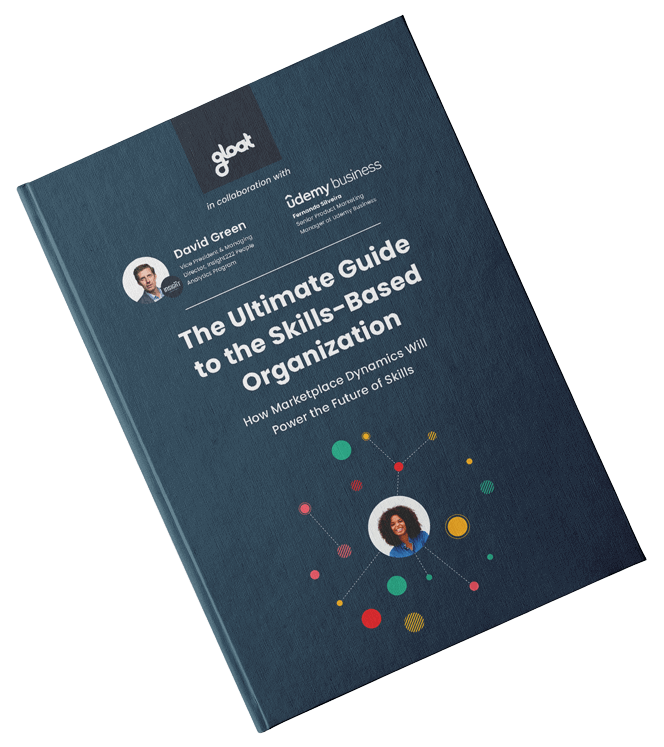How to build a successful upskilling strategy
Learn how to take skill-building efforts to the next level

There’s no doubt that skills are under a spotlight. Most leaders recognize that prioritizing workplace capabilities pays off, as evidenced by the fact that 98% of organizations want to shift to skills-based work and 90% are already experimenting with it.
While skills-based organizations are a relatively new concept, the benefits of this strategy are quickly becoming apparent. Skills-based organizations are 79% more likely to have a positive employee experience—a major advantage considering that employee experience is correlated with less turnover, better performance, and greater revenue.
It’s no surprise that most leaders are moving skills-based strategies to the top of their agendas. However, there’s still a lot of uncertainty about what it takes to build an impactful upskilling initiative and the steps HR leaders can take to get started.
What is upskilling?
Upskilling describes any process that helps someone answer the following question: “What additional skills do I need to learn to progress in my current career?”. It enables businesses to stay competitive in rapidly evolving environments and unlocks the agility needed to get ahead of today’s accelerated pace of change. Since the World Economic Forum predicts that 50% of the global workforce will need to learn new skills by 2025, companies are rolling out enterprise-wide upskilling initiatives to keep from falling behind.
While upskilling often gets used interchangeably with reskilling, the terms have distinct meanings. Reskilling is about helping employees who are interested in switching lanes or taking their careers in a new direction, while upskilling is dedicated to building capabilities within an employee’s chosen career path. There’s also cross-skilling, which recognizes that there are some competencies that everyone must learn, regardless of the role or department they’re in.
Why is upskilling so important right now?
Skill-building has always been important, but recent events are raising the stakes. We’re now entering what’s often called the “Fourth Industrial Revolution,” a time in which advances in AI and automation are revolutionizing the way we work. Since the pace of change is accelerating and the half-life of skills is shrinking, developing new competencies can no longer be an afterthought.
While the rise in automation and AI isn’t going to push employees out of the job market as some people once feared, The World Economic Forum predicts that it will create as many as 133 million new roles. Although that’s good news, these jobs are going to come with new sets of required knowledge—which is where the increased need for upskilling comes into play.
The benefits of implementing an upskilling strategy
Encouraging employees to hone new skills can have major benefits for your people and your business. Some of the top advantages include:
#1. Bridge skill gaps
If your organization doesn’t have the critical skills needed to perform various business functions, you’ll constantly be scrambling to do the research, look things up, and rely on the same talent for support—which only works for so long and quickly becomes inefficient.
Rather than letting skill gaps delay essential work processes, leaders must develop upskilling pathways so employees can continuously build in-demand expertise. Executives need to be aware of potential skill shortages so they can address them before these gaps lead to serious inefficiencies.
#2. Enhanced engagement and retention
If you want employees to stay engaged and inspired, access to skill-building opportunities is non-negotiable. Since 63% of employees who left a job within the last year cited a lack of professional development opportunities as one of their primary reasons for leaving, it’s evident that employees won’t stay at organizations where they feel like their careers are at a standstill. With 77% of workers saying they’re eager to learn new skills, it’s up to leaders to give their people the growth opportunities they’re asking for.
#3. Boost organizational agility and competitiveness
Most leaders know that agility is the answer to preparing for future challenges. Businesses that prioritize upskilling equip their workforces with a wealth of capabilities that managers can then tap into to get critical projects across the finish line. Once employees start deepening and expanding their expertise across many areas of the business, reallocating talent becomes a seamless process.
#4. Future-proof your workforce
Upskilling is a surefire way to help your organization prepare for the next wave of market shifts and changes in consumer demand. When your workforce has a breadth of capabilities and leaders have complete transparency into where knowledge lies, leaders can execute rapid pivots and reallocate talent to overcome new challenges seamlessly. As a result, your business will be able to respond faster and in turn maintain a serious edge over your competitors.
5 steps for HR leaders to develop an upskilling strategy
Now that workforce capabilities are on everyone’s radars, the race to embrace skills-based strategies is on. If you’re looking to launch a top-performing upskilling strategy, here are some tips to get started:
#1. Conduct a comprehensive skills audit
Before launching an upskilling strategy, take stock of the skills your workforce has today. Traditionally, gaining a bird’s eye view of workforce capabilities has been challenging because skills information is typically siloed into a few different HR systems.
Rather than settling for a subpar understanding of workforce skills, leading companies are harnessing AI-powered skills intelligence systems like Gloat’s Skills Foundation to gain visibility into all of their people’s expertise. These platforms are updated in real-time and pull from an employee’s LinkedIn profile or CV, in turn capturing the full range of knowledge they’re bringing to the table.
#2. Prioritize critical skills for your industry
Once you’ve identified the skills your organization has, it’s time to focus on honing the capabilities that will prove most beneficial for your business. As the proliferation of AI continues, employees will need new skill sets to capitalize on the next wave of innovations.
Instead of guessing which skills will become more important in the future, executives can harness skills intelligence systems to understand what knowledge is on the rise and on the decline. The best platforms even forecast shifting skill needs based on industry trends and benchmarking, so leaders can ensure their organizations are outpacing the competition.
#3. Incorporate a mentoring component
Mentoring programs are a surefire way to encourage employees to expand their networks while also picking up new skills. These initiatives are a powerful skill-building tool because they allow people to observe how their more experienced colleagues execute tasks and ask them questions throughout the process. Simultaneously, mentors will develop the leadership skills they need to confidently oversee teams, creating a mutually beneficial relationship for everyone involved.
#4. Design personalized learning pathways
While content-based lessons can help employees get familiar with a subject, hands-on experience is essential for building genuine expertise. To help employees deepen their understanding of various areas of the business, everyone should be encouraged to participate in projects and gigs within other departments. Many visionary companies are harnessing talent marketplaces to generate suggestions for projects, gigs, and even full-time roles that align with employees’ current skill sets and career ambitions.
#5. Establish a culture of continuous learning
Leadership sets the tone for culture—and upskilling is no exception. Executives should strive to partake in their own development opportunities and share their learning experiences to encourage their colleagues and direct reports to follow in their footsteps. To go the extra mile to create a learning culture, leaders and managers should replace talent-hoarding tendencies with talent sharing mindsets, as this type of company-wide mobility will help employees expand their expertise and fuel better cross-functional collaboration.
Best practices for a successful upskilling strategy
Want to take your upskilling initiative to the next level? Consider the following tried-and-true upgrades:
#1. Focus on technical and soft skills
Ultimately, employees need both technical skills and soft skills to excel in their roles and get promoted. People must know how various systems and programs work and understand the step-by-step processes associated with various tasks and deliverables. At the same time, they also must possess specific characteristics such as creativity, curiosity, and attention to detail, which will serve them throughout their careers. The best upskilling programs are designed with equal emphasis on soft skills and technical abilities.
#2. Encourage cross-departmental collaboration
Rather than keeping employees siloed in their specific team or department, top-performing upskilling initiatives create opportunities for cross-functional collaboration that enable workers to build new capabilities and on-the-job experience. When employees are well-versed in what other parts of the organization do and how to work with them, they will be able to advance their careers quickly and understand the why behind the work they’re doing.
#3. Provide incentives for skill development
Building new skills is a challenging process that often requires a combination of curriculum-based coursework and hands-on training opportunities. While it’s in every employee’s best interest to keep adding to their skill sets, some workers may need a little extra motivation to begin their skill-building journey. Consider setting individual goals around learning and development and potentially adding incentives for employees who meet their upskilling goals, such as bonuses or gift cards.
#4. Utilize real-world projects for practical learning
No one can pick up a new skill simply by reading about it. Instead, developing true subject matter expertise requires time in the field. Whether employees are looking to build their coding capabilities or learn graphic design, ensure they have the chance to put their newly acquired skills to the test through projects, gigs, and shadowing opportunities.
To learn more about what it takes to put skills at the center of your strategy, find out how a workforce agility platform can help your business become a skills-based organization.





